

Vol. 39 (Number 47) Year 2018. Page 10
Olga Vladimirovna KOSTENKO 1
Received: 23/05/2018 • Approved: 11/07/2018
ABSTRACT: The new economic policies of states are strongly associated with a cluster approach. In the best world practices the key direction of cluster policy is the formation of networks and support for collaboration. In Russia, clusters networks formation is given insufficient attention. The purpose of the study is to analyze the institutional environment of Russia as a condition for the clusters networks formation. Indeed, problems have been identified, although there are positive trends. It is expedient to adjust the directions and priorities of Russia's cluster policy. Support should primarily be directed towards the formation of stable cluster networks. |
RESUMEN: Las nuevas políticas económicas de los estados están fuertemente asociadas con un enfoque de clúster. En las mejores prácticas mundiales, la dirección clave de la política de clusters es la formación de redes y el apoyo a la colaboración. En Rusia, la formación de redes de clusters recibe atención insuficiente. El objetivo del estudio es analizar el entorno institucional de Rusia como condición para la formación de redes de clusters. De hecho, se han identificado problemas, aunque hay tendencias positivas. Es conveniente ajustar las direcciones y prioridades de la política de clusters de Rusia. El soporte debe estar dirigido principalmente a la formación de redes de clúster estables. |
Scientific and technological development in the modern world is so rapid that it inevitably changes economic relations. New organizational structures and business models are emerging. Of particular importance are the network forms of the organization. After that, the economic policy of states should change. Classical or vertical industrial policy (benefits and subsidies to individual sectors and structures) is a thing of the past. It is replaced by neoclassical or horizontal industrial policy, which is aimed at soft regulation of markets. Since the beginning of the 2000s, the third type of industrial policy has appeared in the advanced countries, first of all in Scandinavia, when the state becomes a network partner and coordinator, improves the business environment, supports cooperation and collaboration (Kuznetsov & Sabel, 2014, Smorodinskaya, 2015). The evolution of network structures led to the appearance of clusters. Their best samples demonstrated high efficiency. At the moment, clusters have become state support objects everywhere in the world. A new industrial policy is often called a clustered approach (Smorodinskaya, 2015, Warwick & Nolan, 2014).
Clusters are a complex economic system, which is characterized by a set of essential characteristics. It is not surprising that in scientific research clusters are the objects of several economic theories. Localization theories investigate the effects of territorial localization (Krugman, 1991) and consider the cluster as the territorial concentration of independent enterprises (the cluster is the type of agglomeration). Theories of competitive advantage (Porter, 1990) examine the factors that ensure the competitiveness of clusters, and supplement the description of clusters with new characteristics. The characteristics are interconnectedness of industries (value chains) and inter-firm networks. Theories of innovation development (Etzkowitz & Leydesdorff, 1995) and the theory of interfirm networks (Sheresheva, 2010) focus on the network properties of clusters.
Thus, theoretically, three main characteristics of clusters are distinguished: territorial localization, interconnectedness of industries (value chain), and network organization. Which of the three characteristics is the most critical in reality? The analysis of the best world practices shows that the cluster policy is mostly aimed at supporting collaboration in a cluster (Lindqvist et al., 2013; Smorodinskaya, 2015), including through the creation and financing of cluster management companies (Porter & Ketels, 2009).
The experience of cluster policy in Russia shows that there are significant differences from the world practice. Since 2012 the Economic Development Ministry of Russia is conducting an experiment to stimulate clusters. Territorial innovation clusters were selected, which were called "pilot" clusters. Studies (Gokhberg & Shadrin, 2015) found that the objectives and methods of forming "pilot" clusters do not fully comply with the standards of the cluster policy of European countries. The organizational development of clusters is especially weak. In Russia, clusters pay more attention to interaction with the state and less - interaction between enterprises (Kutsenko, 2015).
The studies of the European cluster observatory (Sölvell et al., 2003, Ketels et al., 2006) showed that these problems are indeed of particular importance for developing economies. For such countries, there is a lower level of trust between economic agents, a weak business confidence in the state and the domination of the state in cluster initiatives. All this is a barrier to the formation of cluster networks.
The purpose of the study is to analyze the institutional environment of Russia as one of the main conditions that determine the priorities of cluster policy and the successful formation of cluster networks.
The theoretical basis of the research are the academic works of scientists on cluster theory, the theory of network organizations, the theory of institutional economics.
The information-empirical basis of the study includes data from the European cluster observatory, the works of scientists on the analysis of the institutional environment of Russia, the database "Cluster Map of Russia" (https://map.cluster.hse.ru).
Qualitative assessment of the institutional environment, as a rule, is carried out on the basis of an analysis of historical, geographical and cultural character (Kleiner, 2004). The review of scientific publications reveals some special features of the institutional environment of Russian society:
- the predominant type of individual for Russia was and remains "homo institutius" (Kleiner, 2004), and not "homo economicus". In the "homo institutius" society, the personal character of the relationship between agents is more dominant than the economic interest.
The change in public attitudes is due to impulses coming "from the top to down". "Homo institutius" is sensitive to the opinion of "superiors" and is internally ready for a value reorientation;
- for Russia, the polarity of the national mentality is characteristic (Kleiner, 2004; Olsevich, 2010). The main cultural values "scatter" in opposite poles and do not have middle. This largely explains the "explosive nature of development," when the poles of social values are rapidly changing places (the October Revolution of 1917, the reforms of 1991). Russian society is characterized by a low willingness to compromise, an authoritarian type of decision-making prevails. Undoubtedly, this negatively affects the processes of creating inter-firm networks in the economy and interpersonal networks in the society;
- F. Fukuyama (2001) singles out the absence of "interlayers" between a person and the state as a distinctive feature of Russian society. Historically, Russia's civil society has been weakened by centuries of absolutism and an authoritarian regime. Russian citizens do not have a significant experience of interaction with the help of public organizations and negatively assess the role of public mechanisms, which are widespread in a number of developed countries;
- M. Yu. Sheresheva (2006) notes the weakness of the modern system of formal institutions in Russia, and, first of all, it is the provision of property rights. Informal mechanisms of economic activity dominate; they often aim at a hidden redistribution of property. In these conditions, vertically integrated structures that allow controlling ownership are more preferable than inter-company networks.
To obtain quantitative estimates, indirect economic indicators are used, as well as the method of sociological surveys.
The methodology (Balatskii & Ekimova, 2015) is based on the use of economic indicators. The authors constructed a composite index of institutional development. The calculations are based on the example of eight countries. The group included both developed countries and transitive post-Soviet economies (Figure 1).
Figure 1
Indices of institutional development, 2013
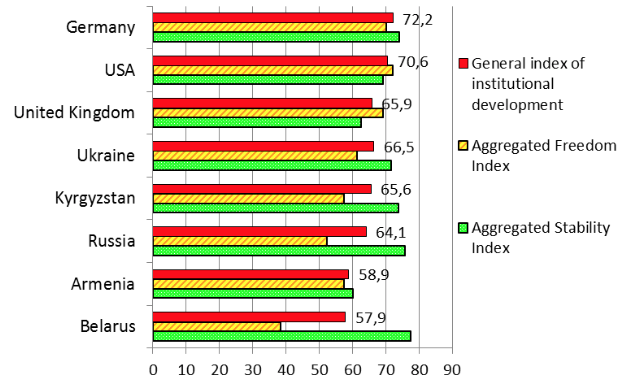
The data are from "The Effectiveness of Russia's Institutional Development: An Alternative Assessment",
by E.V. Balatskii, N.A. Ekimova, 2015, Terra Economicus, Vol.13, №4, p.31-51. Copyright (2015) by E.V. Balatskii, N.A. Ekimova
In general, in terms of the level of institutional development, Russia is inferior to developed countries. However, the division of the index into parts shows that, by the criterion of guarantees, Russia is not inferior to the leaders, and by the criterion of freedoms is among the outsiders. On the one hand, conditions have been created in Russia that excludes serious social upheavals. On the other hand, restriction of freedoms hinders development, affects creative activity, innovation and expansion of network interactions negatively.
The dynamics of institutional development shows that although Russia is far from the standard model with developed public institutions, it is not as bad as Western ratings suggest (Figure 2).
Figure 2
Dynamics of institutional indices in Russia
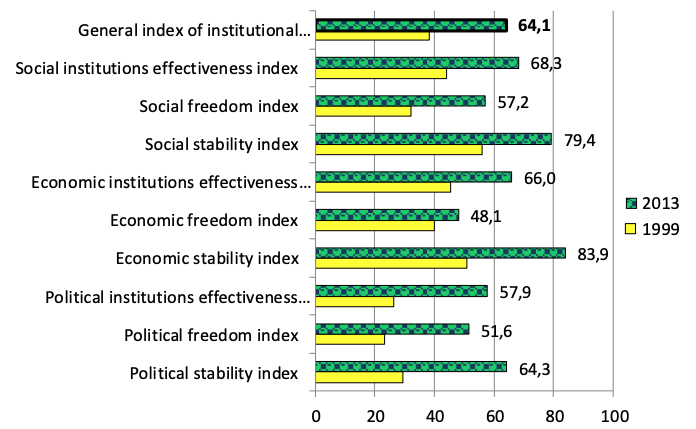
The data are from "Factor structure of the parameters of personal and institutional
trust in modern Russia (the experience of empirical analysis)", by V.A. Davidenko,
G.S. Romashkin, 2010, Terra Economicus, Vol.8, №3, p.134-142.
Copyright (2010) by V.A. Davidenko, G.S. Romashkin
The second group of institutional analysis methods uses data from sociological surveys. Studies (Davidenko & Romashkin, 2010) are based on data from Russian nationwide surveys. The results of the analysis of interpersonal trust are shown in Figure 3.
Figure 3
Dynamics of trust between people in Russia, in % to respondents

The data are from "Factor structure of the parameters of personal and institutional
trust in modern Russia (the experience of empirical analysis)", by V.A. Davidenko,
G.S. Romashkin, 2010, Terra Economicus, Vol.8, №3, p.134-142.
Copyright (2010) by V.A. Davidenko, G.S. Romashkin
Interpersonal trust is the basis of any society. Studies show that the restoration of trust in Russian society is slow. Until now, there has been no return to the level characteristic of the period before the economic reforms of 1991.
The level of institutional trust allows assessing the structure of civil societies. Indices in the context of social organizations are shown in Figure 4.
Figure 4
Indices of institutional trust in Russia, 2009 (0 - all do not trust, 100 - all trust)
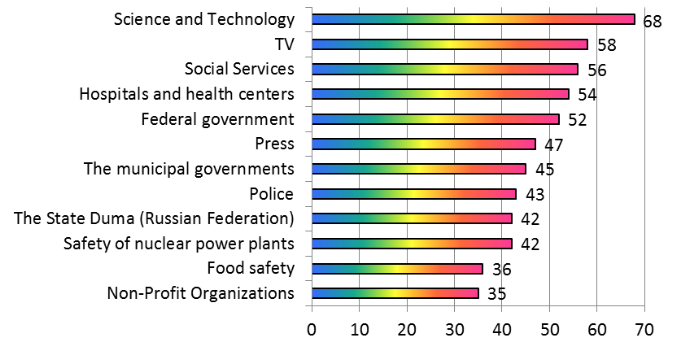
The data are from "Factor structure of the parameters of personal and institutional
trust in modern Russia (the experience of empirical analysis)", by V.A. Davidenko,
G.S. Romashkin, 2010, Terra Economicus, Vol.8, №3, p.134-142.
Copyright (2010) by V.A. Davidenko, G.S. Romashkin
The level of confidence is quite low in almost for all institutions. Researchers (Davidenko & Romashkin, 2010) interpret this as evidence of considerable estrangement of Russian citizens from power.
The data of the Russian cluster observatory project "Cluster Map of Russia" (National Research University "Higher School of Economics", Moscow) were used. The database contains questionnaires of 115 Russian clusters (the date of circulation is May 20, 2018).
The processing of questionnaires, documents and cluster sites shows that the initiative to create Russian clusters comes from government bodies in most cases. In 30% of cases, these are cluster initiatives of regional governments, another 51% are joint initiatives of business and government. Such data are close to the results of the European Cluster Observatory studies (Sölvell et al., 2003).
However, there are significant differences in the formation of cluster management companies. According to (Lindqvist et al., 2013), 65% of cluster initiatives are registered as a separate legal entity (or subdivision in its composition) in the world and only 35% choose the option of an informal organization. In Russia the ratio is the opposite, 73% of clusters conclude an agreement (a contract without the formation of a legal entity). In 65% of cases, the functions of cluster management companies are vested in regional governments and development institutions (Cluster Development Centers, Entrepreneurship Support Funds, etc.).
Among the methods of forming clusters, the main attention is paid to such aspects as the preparation and signing of agreements to create the clusters, the planning of strategies and programs for the development of clusters. To a certain extent, such standards were set by the Economic Development Ministry of Russia (Methodological materials, 2016), where the organizational development of clusters and the cluster networks is revealed superficially and incompletely.
To assess the intensity of the cluster networks formation, several criteria were used. It is perfectly natural to use the Internet to networks forming. However, only 44% of Russian clusters have a website, another 21% of clusters use a simplified version (cluster page on the Cluster Development Center website). Surprisingly, a third of the clusters (35%) do not lead the site. As a result, access to the terms of joining the cluster is not public, and this is a barrier to the cluster networks formation (Figure 5).
Figure 5
Sites where information is posted on the conditions of entry
into the cluster (the number of clusters, as of May 20, 2018)
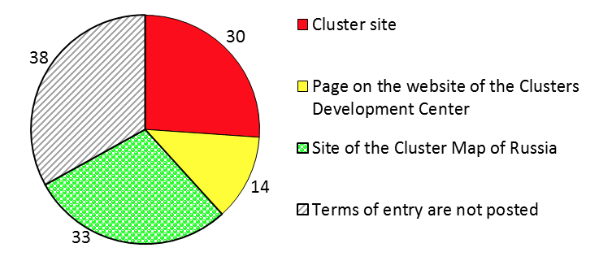
The data are from “Cluster Map of Russia” (URL: http://map.cluster.hse.ru/)
The result of the cluster networks formation can be assessed by the presence of cluster projects. Unfortunately, half of Russian clusters did not present information about cluster projects (Figure 6).
Figure 6
Clusters: the availability of three cluster projects
types (the number of clusters, as of May 20, 2018)
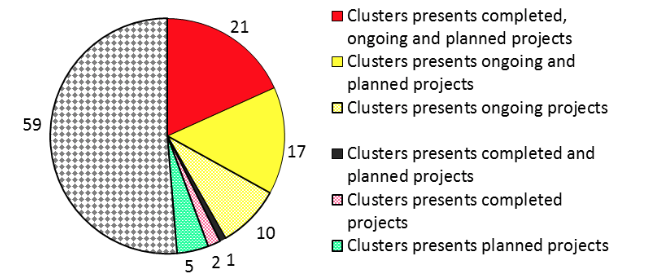
The data are from “Cluster Map of Russia” (URL: http://map.cluster.hse.ru/)
Only a fifth of clusters have both implemented cluster projects, and implement current projects and plan new projects in the future.
The facts presented above show that certain characteristics of the institutional environment in Russia are an obstacle to the application of a new "soft" economic policy, including the cluster approach. Indeed, the processes of cluster networks formation are slower than planned and required by the pace of world economy development.
Russian mentality is characterized contradiction and duality, a low willingness to make concessions and find compromise solutions in disputed situations. The formal institutions system is in the process of formation. Insufficiently effective formal institutions are replaced by informal regulatory mechanisms. A significant share of fears is associated with institutional traps, especially there are corruption and so-called bureaucratic rents (Kutsenko, 2012). Unfortunately, in Russian society, both the interpersonal trust and the trust in government bodies and public institutions are still not high. According to the data (Markov et al., 2011), even the creative class exhibits a certain social inertia.
However, the analysis also shows that there is a favorable dynamic of institutional development in Russia. It is necessary to further strengthen formal institutions, primarily the institution of property rights and the eradication of corruption. Positive institutional changes are also necessary to create a new business environment and a culture of interaction. It is possible that stimulating clusters and cluster networks will become one of those "training areas" where new standards of interaction will be developed.
The state, as a stronger partner, should place greater responsibility in this area. The format of the new "soft" industrial policy forces governmental agencies and institutions to change roles and methods of work. Existing standards and rules of their work do not meet the new requirements. Today many researchers and practitioners realize this. However, this is not so easy to do in reality. According to some studies (Loginov, 2015), there are cases when regional authorities perceive clusters as a competitor in the industry management. Obviously, special measures will be required to transform the state officials culture (Zharkova, 2013).
Specific complaints are expressed regarding to the cluster policy of Russia (Zharkova, 2013). Regional governments seek to accelerate the clusters formation, there is a planned selection of participants "from above", do not take into account the stage of self-organization of clusters. The state should not assume the functions of cluster members, nor should it seek to have a majority in the clusters councils.
Network forms of cooperation can’t be imposed by force (Sheresheva, 2006). However, now the priority is to subsidize cluster projects more. Clusters organizational development is ignored.
An important point is subsidizing the cluster networks formation. Cluster initiatives are associated with certain costs, and they are distributed asymmetrically. Leading enterprises of cluster initiatives take upon themselves the organization of meetings and events, various coordination and development of joint projects, preparation of draft documents and lobbying in government. Even if successful, benefits will be shared among all participants, and the costs of initiators may not pay off (Kutsenko, 2012). The presence of costs and their uncertainty, as well as cultural inertia, hinder changes (Polterovich, 1999). Subsidizing the clusters management companies from the budget is able to resolve this contradiction.
In this case, feedback should become an indispensable element of cluster initiatives. Feedback in the political system provides control over the subject of power and mechanisms for changing the system. In the civil society and in the authorities, special bodies are created and normative and legal acts are adopted that establish mechanisms, forms and procedures for feedback (Zaitsev, 2012). The process of feedback institutionalizing serves as an indicator of political and democratic development of society (Abdullaeva, 2009). This is fully true for regional governments and cluster management companies. A same mechanism is successfully used, for example, in clusters of Upper Austria (Kutsenko, 2014).
Studies (Latov & Latova, 2007) show the need to differentiate economic reforms by region. The Russian regions have significant differences of the institutional environment. Same conclusions were obtained by other Russian researchers (Markov et al., 2011; Davidenko & Romashkin, 2010).
Accelerating innovations and the organizational structures evolution have led to the emergence of a new industrial policy. The state becomes a network partner and coordinator, improves the business environment, support cooperation. New industrial policies are often associated with a cluster approach.
Analysis of the best world practices shows that the main direction of cluster policy is the networks formation and support for cluster cooperation. Russia's experience reveals significant differences in comparison with world practices. Clusters pay more attention to interaction with the state and less - the interaction between enterprises.
Some characteristics of the Russian institutional environment prevent the use new "soft" industrial policy. The cluster networks formation is slower than planned and required by the pace of world economy development.
However, in Russia there is a favorable dynamic of institutional development. It is possible that forming cluster networks will become one of those "training areas" where new standards and interaction skills will be developed.
The format of the new "soft" industrial policy forces the government agencies and institutions of Russia to change roles and methods of work. Specific complaints are expressed regarding cluster policy. Following the example of foreign programs, the goal of Russia's cluster policy should be cluster networks formation. Programs for subsidizing cluster management companies are strongly recommended. Feedback (control of government bodies and cluster management companies) should become an indispensable element of cluster initiatives. When developing regional cluster policies, the characteristics of the regional institutional environment should be taken into account.
Balatskii, E.V., Ekimova, N.A. (2015). The Effectiveness of Russia's Institutional Development: An Alternative Assessment. Terra Economicus, vol.13, № 4, p.31-51.
Davidenko, V.A., Romashkin, G.S. (2010). Factor structure of the parameters of personal and institutional trust in modern Russia (the experience of empirical analysis). Terra Economicus, vol.8, №3, p.134-142.
Etzkowitz, H., Leydesdorff, L. (1995). The Triple Helix - University-Industry-Government Relations: A Laboratory for Knowledge-Based Economic Development // EASST Review, vol.14, №1, p.14-19.
Fukuyama, F. (2001). Trust: social virtues and the creation of prosperity. Emergency ration, №2 (16). Retrieved from: http://magazines.russ.ru/nz/2001/2/fook.html.
Gokhberg, L.M., Shadrin, A.E. (2015). Pilot innovative territorial clusters in the Russian Federation: directions for the implementation of development programs. Moscow: NRU HSE, 92p.
Ketels, C. H. M., Lindqvist, G. and Sölvell, Ö. (2006). Cluster Initiatives in Transition and Developing Economies. Stockholm: Center for Strategy and Competitiveness, 42p.
Kleiner, G.B. (2004). Evolution of Institutional Systems. Moscow: Science, 240p.
Krugman, P.R. (1991). Increasing returns and economic geography. Journal of Political Economy, vol.99, p.483-499.
Kutsenko, E. (2012). Rational cluster strategy: maneuvering between market failures and state failures. Forsyte, vol.6, №3, p.6-15.
Kutsenko, E.S. (2014). Conditions for the formation of effective communication in a cluster. Schumpeterian readings, vol.1, p.100-105.
Kutsenko, E. (2015). Pilot Innovative Territorial Clusters of Russia: a Model for Sustainable Development. Forsyte, vol.9, №1, p.32-55.
Kuznetsov, Y., Sabel, C. (2014). New Open Economy Industrial Policy: Making Choices without Picking Winners. In: OECD, World Bank. Making Innovation Policy Work: Learning from Experimentation. Paris: OECD Publishing.
Latov, Yu.V., Latova, N.V. (2007). Discoveries and paradoxes of the ethnometric analysis of Russian economic culture by the method of G. Hofstede. The World of Russia, №4, p.43-72.
Lindqvist, G., Ketels, C., Sölvell, Ö. (2013). The Cluster Initiative Greenbook 2.0. Stockholm: Ivory Tower Publishers, 66p.
Loginov, D.A. (2015). Cluster mechanism for ensuring food security in the region. Bulletin of the Academy, №4, p.121-124.
Markov, L.S., Markova, V.M., Kazantsev, K.Yu. (2011). Institutional mechanisms of innovative development of Russian regions. Region: Economics and Sociology, №4, p.19-38.
Methodological materials on the development and implementation of programs for the development of innovative territorial clusters and regional cluster policy. (2016). Moscow: NRU HSE, 208p.
Olsevich, Yu. Ya. (2009). Psychological basis of economic behavior. Moscow: INFRA-M, p. 351-368.
Polterovich, V.M. (1999). Institutional traps and economic reforms. Economic end mathematical methods, vol.35, №2, p.3-20.
Porter, M.E. (1990). The Competitive Advantage of Nations. New York: Free Press, 875p.
Porter, M.E., Ketels, C.H.M. (2009). Clusters and Industrial Districts: Common Roots, Different Perspectives. In: A Handbook of Industrial Districts / ed. G. Becattini, M. Bellandi, L. de Propis. Cheltenham: Edward Elgar, p.172-186.
Sheresheva, M.Yu. (2006). Interorganizational networks in the system of forms of functioning of modern industrial markets: abstr. of diss… doc. econ. science. Moscow, 53p.
Sheresheva, M.Yu. (2010). Forms of network interaction between companies. Moscow: NRU HSE, 339 p.
Sölvell, Ö., Lindqvist, G., Ketels, C. (2003). The Cluster Initiative Greenbook. Stockholm: Ivory Tower AB, 66p.
Smorodinskaya, N.V. (2015). The globalized economy: from hierarchies to a networked way of life. Moscow: EI RSA, 344 p.
Warwick, K., Nolan, A. (2014). Evaluation of Industrial Policy: Methodological Issues and Policy Lessons. OECD Science, Technology and Industry Policy Papers. № 16.
Zharkova, E.S. (2013). Network forms of integration of economic entities: institutional analysis: abstr. of diss… PhD. econ. science. St. Petersburg, 28p.
1. Economics faculty, Vyatka State Agricultural Academy, 610017, Russian Federation, Kirov, Oktyabrsky prospect, 133, kostenko_ov@vgsha.info